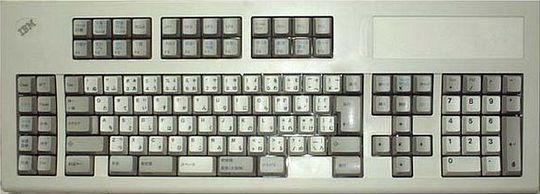
Brief Introduction (K/B for Multistation, 5576 series)
Characteristic Features
Useful links about 5576 K/B
Localized Curved sculpture
Keyboard Connectors
Compatibility issue
5576-001
5576-002
5576-003
5576-A01
5576-C01
5576-B01
Content created by Sandy. Edited by Major Tom. Most of the information
regarding key mechanisms and history of IBM keyboards is based on the following
sites - Kenjin
(maintained by "IT") and Qwerters Clinic
(maintained by Mr. Tanaka).
Brief Introduction
Multistation Keyboards
Before talking about 5576 keyboards, I'd like to introduce keyboard for
Multistation 5550, computers sold by IBM Japan before MCA PS/55 series.
5556 keyboard is known as
associated keyboard for Multistation series. 5556 somehow looked like keyboard
for "The PC" (and PC/XT), but the key mechanism used for 5556 was different
from that of The PC which used tactile Buckling spring technology. IBM Japan
ordered Alps Electric Co. Ltd. new key switch and Alps made their unique "Leaf
Spring" and "mechanical contact" switch. Though the Alps switch used for 5556
and alternate keyboards for Multistation series didn't provide clicking noise,
the key mechanism was actually a kind of so-called "Mechanical Key". I have not
yet touched the keyboard actually so I can't say how the keyboard feel like.
The keyboards use new scancode sets (81h, 82h, 8Ah) to support the additional
keys (which limits its compatibility).
Here you can see photo images of 5556
and 4773313
(the site is maintained by Mr. IT) and also you can compare how they
differ from IBM "The PC" Keyboard
and alternatives.
5576 Keyboards for the PS/55 Line
US IBM introduced their great 101 keys Enhanced keyboard
with Buckling spring/Membrane contacts mechanism along with PS/2 in 1987.
But IBM Japan didn't use IBM's own products but again used Alps key
switch "with tactile sound" for their new PC series PS/55,
Japanese localized PS/2. Thus keyboard 5576-001 and 002 introduced
to the market.
Key layout of 5576-001 is very different from that of Model M. Roughly
speaking it looks like 1390876.
It has 24 function keys and 10 enhanced keys and was essentially designed to be
used with PS/55s as a terminal machines of mainframes (of course those could be
used as usual PC systems). 5576-002 has 106 keys (5 keys are added in order
to provide Japanese environment) and more looks like Model M layout. Major
difference of its layout is that 002 does not have left "Alt" key as like as
001. Later on when IBM Japan tended to consumer market with their DOS/V
technology, they made new keyboard, 5576-A01, which was based on 002 but the
key layout was rearranged and was followed to Model M to keep operative
compatibility. For the new keyboard, IBM Japan ordered Brother Industries. Ltd.
to make "Buckling spring key" under cross-license to meet with Japanese users'
taste.
As described above, PS/55 keyboards are bit different from PS/2 world. The
Model M is really a great keyboard and there are so many M-maniacs in Japan
too, but at least for me both 5576-002 and 5576-A01 are the second to None. I
like 5576-002 and A01.
Characteristic Features of 5576 Keyboards
| Type |
# of Keys |
Mechanism |
Notes |
| 5576-001 |
124 |
Leaf spring |
Alps switch, PS/55 layout |
| 5576-002 |
106 |
Leaf spring |
Alps switch, PS/55 layout |
| 5576-003 |
99 |
Buckling spring |
Brother switch, PS/55 Layout |
| 5576-A01 |
106 |
Buckling spring |
Brother Switch, OADG1) DOS/V layout |
| 5576-C01 |
98 |
Buckling spring |
Ditto, with Trackpoint II |
| 5576-B01 |
106 |
Rubber dome |
OADG DOS/V layout |
| And more... |
Notes:
1) OADG - Open Architecture Developers' Group (a consortium leaded by IBM Japan
to distribute IBM Japan's new technology regarding Japanese (double bytes
characters) handling on DOS without any help of special hardware but just 2MB
of RAM and 386SX CPU and higher with some added device drivers to PC DOS
(or MS DOS).
Except key switch mechanism and the layout of the keys, 5576 series
are very similar to model M.
Both use Mechanical spring (5576-001/002 use Leaf spring though)
"tactile" feedback
Curved sculpture design were applied
Removable key caps are used
Keyboard cable is detachable from a keyboard unit
Mechanical Spring and Clicking Sound
I'm not a technical writer and I don't know much about key mechanism. So I'd
like to reference some nice pages covering keyboard mechanisms. These pages are
mostly written in Japanese but you can still observe the photos):
- Alps switch (leaf spring with mechanical contacts) used for 5576-001 and 002 (archive)
- Brother switch (buckling spring with membrane contacts) (archive)
- Curved sculpture (archive). Explains the difference between earlier and latter 002.
Localized Curved Sculpture
Distinctive Difference (shape of the space bar)
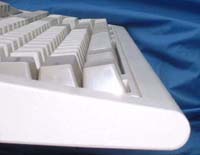 |
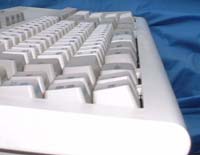 |
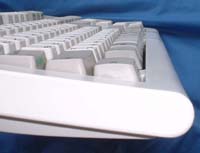 |
| Model M |
5576-001 |
5576-A01 |
All of the most lower keys of Model M keyboard (space bar, Alt, Ctrl and
numeric keys) are keeping same shapes and key tops are in same curves. While
front edge of space key, Ctrl and Alt keys (and other associated Japanese
specific keys around space bar) of 5576 are slightly cut off. 5576-001 (picture
in middle) shows the difference of the shape.
Front two keys seeing the
picture (two keys at most left facing to the actual keyboard) are added
enhanced keys and the position of 3rd key is equal to Ctrl on M keyboard.
Height of the edge of those keys give smooth touches especially to both thumb
fingers.
And here's one more arrangement made by IBM Japan.
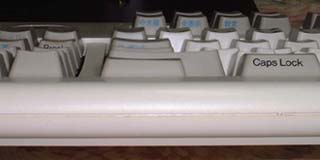 |
Could you notice the fact that the middle key (same position of left Ctrl of
Model M) is slightly shorter than the neighboring
right key which is marked as Caps Lock (it's 001 keyboard)? The Ctrl key at the
right side is in same height. These two keys are usually pressed with little
fingers, and (at least for Japanese) this modification makes us easier to type
those keys.
|
Removable Key Caps
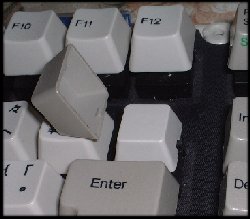 |
5576-A01
Dimensions of key tops and caps are different from the Model M so it's not
possible to interchange key caps between the 5576 and Model M.
|
Keyboard Connectors
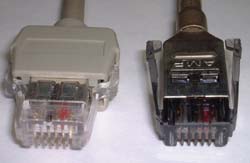 |
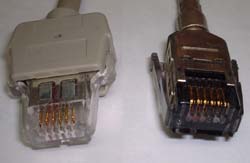 |
| Top view, left - PS/55, right - Model M |
Bottom view, left - PS/55, right - Model M |
Connector Pinout
Outlines by John Szybowsky (see his mod page).
Model M pinouts can be found HERE.
Compatibility Issue (for Japanese readers only)
There are compatibility issue for 5576-001/002/003 regarding their S/N and
EC level to use with some of PS/55s. Please read here.
OS support (001/002/003):
- Windows ME doesn't support the 001/002/003 keyboards.
- Windows 2000/XP does have keyboard DLL file for the 001/002/003 but you
can't select these keyboard using device manager. You have to either modify the
keyboard or manually select the DLL file by modifying Windows registry. More
information can be found
HERE (archived, JP).
5576-001 (5576 Keyboard-1 P/N 94X1220)
- Alps leaf-spring key switches with mechanical contacts
- Audible and tactile feedback (it actually has a speaker at the bottom)
- 124-key Japanese 001 layout
- Removable key caps
- Detachable keyboard cable
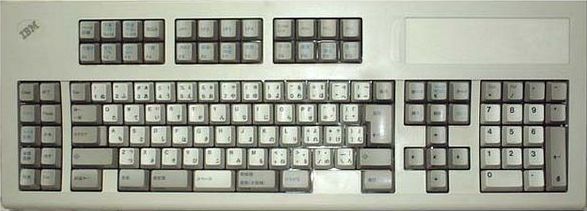 |
| 5576 Keyboard-1 (P/N 94X1220). Another photo HERE. |
Thin but huge keyboard this one is. It has 24 function keys and 10 enhanced
keys. Key layout looks like that of Emulator 122.
Enhanced keys were basically for IBM Japan's proprietary word Processing
software "DOS Bunsho Program" which had been sold since Multistation 5550
series. PS/55s were sometimes used as terminal emulators at some big companies
along with Multistation series. So the key layout was not so ridiculous at that
time, I suppose.
Alps Key switches gives really good response. Requires lesser pressing force
than Model M. but gives firm and sure typing response. Not so loose as Model M,
gives tight clicking sound (reverberation of metal spring is tight and firm
comparing to Model M). Disadvantage of this keyboard is it's unique key layout.
Win95/98 support this keyboard in native but neither Win 2000 nor XP provide
keyboard file officially (though both of them have keyboard DLL for this
keyboard and it is possible to use it rewriting window's registry data)
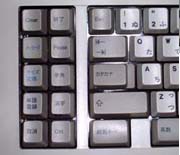 |
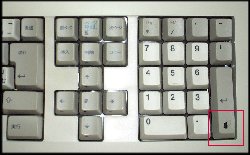 |
| Enhanced keys (alt) |
Cross-layout cursor keys (alt) |
 |
| Double-row function keys |
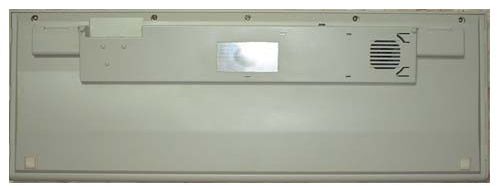 |
| Bottom view (there's a speaker behind the grill) |
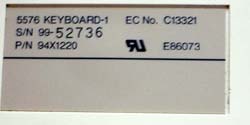 |
| Keyboard label |
5576-002 (5576 Keyboard-2 P/N 94X1110)
- Alps leaf-spring key switches with mechanical contacts
- Audible and tactile feedback (it actually has a speaker at the bottom)
- 106-key Japanese 002 layout
- Removable key caps
- Detachable keyboard cable
 |
| 5576 Keyboard-2 (P/N 94X1110). Another photo HERE. |
Also uses Alps Key switch with mechanical contacts. Touching response is
basically same with 001 keyboard. It doesn't have added 12 function keys and 10
enhanced keys seen in 001. Key Layout is the nearly same with latter A01 model
and thus the layout is supposed to be origin for that of A01. Main difference
is that 002 dose not have Alt Key at left side of space bar, it has only one
Alt key at the right hand side.
Alternative of this keyboard is labeled as 55760N2 with P/N 07G3331.
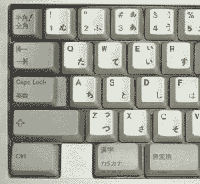 |
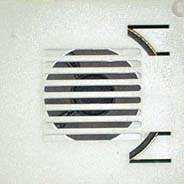 |
| Kanji key below Z/X |
Speaker behind a grill |
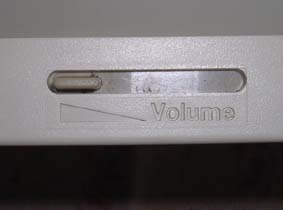 |
| Speaker volume adjustment |
5576-003 (5576 Keyboard-3 P/N 66X1121)
- Brother buckling spring key system
- Membrane contacts
- Tactile feedback
- 89-key Japanese A01 Layout
- Removable key caps
- Detachable keyboard cable
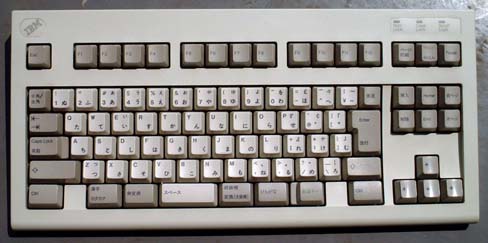 |
| 5576 Keyboard-3 (P/N 65X1121) |
Key layout is same with 5576-002 (Keyboard-2). As you can see this model has
no numeric keys. Key switch mechanism used for this model is not, unlike 002,
Alps made but Buckling spring mechanism made by Brother Industry Co. Ltd which
is also used in 5576-A01.
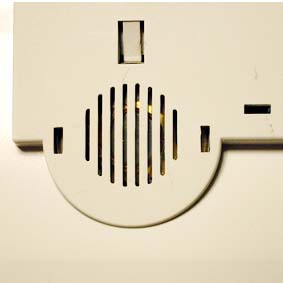 |
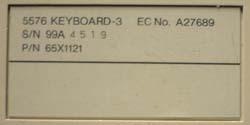 |
| Speaker |
Keyboard Label |
5576-A01 (P/N 79F0167)
- Brother buckling spring key system
- Membrane contacts
- Tactile feedback
- 106-key Japanese A01 layout
- Removable key caps
- Detachable keyboard cable
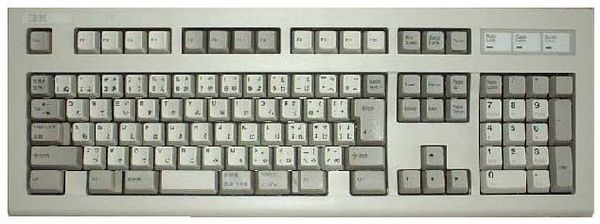 |
| 5576-A01 Keyboard (P/N 79F0167) |
My favorite one. Have no appropriate words to describe how good it is.
Requires much pressing force than the 002 keyboard and repercussion may be
harder than 002. But I like it.
Please go HERE
(archived original)
for the mechanism of this keyboard. The site is maintained by Mr. Tanaka.
you can observe how the key spring works in moving photo images.
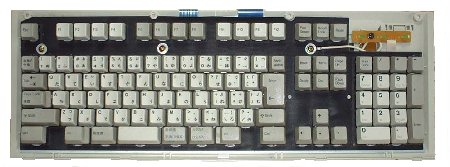 |
| Inner view |
5576-C01 (With a TrackPoint-II, kind of SpaceSaver)
- IBM buckling spring key system
- Membrane contacts
- Tactile feedback
- 89-key Japanese A01 layout
- Permanently attached cable
No picture available. Please check
this site
for pictures of the C01 keyboard.
This one was most likely made by IBM US for IBM Japan. The original model of
this keyboard might be
Mode l M13 Trackpoint II (92G7461).
Or Eudora Pro UNI04G6
made by Unicomp is more likely to be its origin if IBM (or Lexmark) had once
sold such a keyboard. Outlook is almost same with each other except UNI04G6
does not have a rotating bar used as a leg to keep the keyboard vertically when
it is not in use. I do not know whether IBM Japan designed 5576-C01 and ordered
US IBM to make it or US IBM had already had that kind of model and just
arranged key layout to meet with Japanese market.
This keyboard was introduced to the market as associated keyboard of earlier
models of PS/55E 5538 and 5537. As I wrote in 5538 section, there are two types
of this model, one is with with single cable to be connected to K/B port of
5537/5538 which works for TrackPoint II and the other is with "Y cable"
separated to K/B connector and mouse connector. The former is P/N 66G8363 and
the latter is P/N 66G8362. See the 5538 section
too.
Now I don't have C01. I'm so stupid that I disposed my C01 which had bad
film cable which caused keyboard error repeatedly. I should have kept it for
repairing purpose.
Key touch response is... not so good. It might be derived from Model M and
actually it gives tactile feedbacks but it is not "M". Design is good,
product concept is also good, TrackPoint II on a standard full-key layout may
save space for mouse operation. Buckling spring technology should be good
but... could it be better? It gives you just noisy tactile sounds. Do not
expect C01 for model M's quality. You'll be disappointed, I swear it. But I do
want to have a 5576-C01 in good working condition as an associated keyboard for
my 5538. So far it is better than cheap rubber dome spring keyboards such as
5576-B01 and others.
Later Models
There are few more members of the 5576 keyboard family, that came after the
A01 model and were sold mainly with the Aptiva or new IBM PC series. These
keyboards use rubber dome spring mechanism and membrane contacts. These are not
my choice.
5576-B01
Some people says this one belongs to mechanical keyboards but as far as I
can see, it uses rubber dome spring and membrane contacts. Actually it is
different from today's usual cheapo K/B and it gives relatively firm typing but
so it was a starter of IBM's cheap K/B (and the End of the High quality
Desktop keyboards).
5576-B05
No information currently.
|